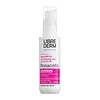Cetaphil Daily Hydrating Lotion with Hyaluronic Acid Versus LIBREDERM Rosacellin Soothing Day Cream SPF 30
What's inside
What's inside
 Key Ingredients
Key Ingredients

 Benefits
Benefits

 Concerns
Concerns

 Ingredients Side-by-side
Ingredients Side-by-side

Water
Skin ConditioningDicaprylyl Carbonate
EmollientCyclopentasiloxane
EmollientGlycerin
HumectantHydroxyethyl Urea
HumectantGlyceryl Stearate
EmollientPEG-100 Stearate
Acrylates/C10-30 Alkyl Acrylate Crosspolymer
Emulsion StabilisingCaprylyl Glycol
EmollientCetyl Alcohol
EmollientErythritol
HumectantGlycine Soja Oil
EmollientHomarine Hcl
Skin ConditioningHydrolyzed Hyaluronic Acid
HumectantPhenoxyethanol
PreservativePotassium Sorbate
PreservativeSodium Benzoate
MaskingSodium Hydroxide
BufferingSodium PCA
HumectantTocopherol
AntioxidantWater, Dicaprylyl Carbonate, Cyclopentasiloxane, Glycerin, Hydroxyethyl Urea, Glyceryl Stearate, PEG-100 Stearate, Acrylates/C10-30 Alkyl Acrylate Crosspolymer, Caprylyl Glycol, Cetyl Alcohol, Erythritol, Glycine Soja Oil, Homarine Hcl, Hydrolyzed Hyaluronic Acid, Phenoxyethanol, Potassium Sorbate, Sodium Benzoate, Sodium Hydroxide, Sodium PCA, Tocopherol
Water
Skin ConditioningHomosalate
Skin ConditioningOctocrylene
UV AbsorberButyl Methoxydibenzoylmethane
UV AbsorberEthylhexyl Salicylate
UV AbsorberCaprylic/Capric Triglyceride
MaskingC12-15 Alkyl Benzoate
AntimicrobialCyclopentasiloxane
EmollientIsononyl Isononanoate
EmollientHydroxyethyl Urea
HumectantCetearyl Alcohol
EmollientPotassium Cetyl Phosphate
EmulsifyingPolyglyceryl-3 Methylglucose Distearate
EmulsifyingGlycerin
HumectantPolymethylsilsesquioxane
Ethylhexyl Triazone
UV AbsorberDiethylamino Hydroxybenzoyl Hexyl Benzoate
UV FilterButylene Glycol
HumectantVincetoxicum Atratum Root Extract
EmollientCornus Officinalis Fruit Extract
Skin ConditioningInulin
Skin ConditioningAlpha-Glucan Oligosaccharide
CleansingTroxerutin
Skin ConditioningMagnolol
AntioxidantHonokiol
AntioxidantPolyglyceryl-10 Laurate
Skin ConditioningPolyglyceryl-6 Oleate
EmulsifyingSorbitan Palmitate
EmulsifyingDimethyl Sulfone
SolventCaffeine
Skin ConditioningRibes Nigrum Seed Oil
EmollientDipotassium Glycyrrhizate
HumectantDiethylhexyl Syringylidenemalonate
Skin ProtectingHydroxyethyl Acrylate/Sodium Acryloyldimethyl Taurate Copolymer
Emulsion StabilisingIsohexadecane
EmollientPolysorbate 60
EmulsifyingXanthan Gum
EmulsifyingParfum
MaskingPhenoxyethanol
PreservativeEthylhexylglycerin
Skin ConditioningChlorphenesin
AntimicrobialTitanium Dioxide
Cosmetic ColorantMica
Cosmetic ColorantTin Oxide
AbrasiveDisodium EDTA
Water, Homosalate, Octocrylene, Butyl Methoxydibenzoylmethane, Ethylhexyl Salicylate, Caprylic/Capric Triglyceride, C12-15 Alkyl Benzoate, Cyclopentasiloxane, Isononyl Isononanoate, Hydroxyethyl Urea, Cetearyl Alcohol, Potassium Cetyl Phosphate, Polyglyceryl-3 Methylglucose Distearate, Glycerin, Polymethylsilsesquioxane, Ethylhexyl Triazone, Diethylamino Hydroxybenzoyl Hexyl Benzoate, Butylene Glycol, Vincetoxicum Atratum Root Extract, Cornus Officinalis Fruit Extract, Inulin, Alpha-Glucan Oligosaccharide, Troxerutin, Magnolol, Honokiol, Polyglyceryl-10 Laurate, Polyglyceryl-6 Oleate, Sorbitan Palmitate, Dimethyl Sulfone, Caffeine, Ribes Nigrum Seed Oil, Dipotassium Glycyrrhizate, Diethylhexyl Syringylidenemalonate, Hydroxyethyl Acrylate/Sodium Acryloyldimethyl Taurate Copolymer, Isohexadecane, Polysorbate 60, Xanthan Gum, Parfum, Phenoxyethanol, Ethylhexylglycerin, Chlorphenesin, Titanium Dioxide, Mica, Tin Oxide, Disodium EDTA
 Reviews
Reviews

Ingredients Explained
These ingredients are found in both products.
Ingredients higher up in an ingredient list are typically present in a larger amount.
Cyclopentasiloxane, or D5, is a silicone used to improve texture of products and trap moisture.
D5 is considered lightweight and volatile. Volatile means it evaporates quickly after application. Once evaporated, D5 leaves a thin barrier that helps keep skin hydrated.
It is also an emollient. Emollients help soften the skin and prevent water loss. Silicones create a silky texture in products. D5 helps other ingredients become more spreadable.
Studies show D5 is safe to use in skincare products. We recommend speaking with a skincare professional if you have concerns.
Learn more about CyclopentasiloxaneGlycerin is already naturally found in your skin. It helps moisturize and protect your skin.
A study from 2016 found glycerin to be more effective as a humectant than AHAs and hyaluronic acid.
As a humectant, it helps the skin stay hydrated by pulling moisture to your skin. The low molecular weight of glycerin allows it to pull moisture into the deeper layers of your skin.
Hydrated skin improves your skin barrier; Your skin barrier helps protect against irritants and bacteria.
Glycerin has also been found to have antimicrobial and antiviral properties. Due to these properties, glycerin is often used in wound and burn treatments.
In cosmetics, glycerin is usually derived from plants such as soybean or palm. However, it can also be sourced from animals, such as tallow or animal fat.
This ingredient is organic, colorless, odorless, and non-toxic.
Glycerin is the name for this ingredient in American English. British English uses Glycerol/Glycerine.
Learn more about GlycerinPhenoxyethanol is a preservative that has germicide, antimicrobial, and aromatic properties. Studies show that phenoxyethanol can prevent microbial growth. By itself, it has a scent that is similar to that of a rose.
It's often used in formulations along with Caprylyl Glycol to preserve the shelf life of products.
Water. It's the most common cosmetic ingredient of all. You'll usually see it at the top of ingredient lists, meaning that it makes up the largest part of the product.
So why is it so popular? Water most often acts as a solvent - this means that it helps dissolve other ingredients into the formulation.
You'll also recognize water as that liquid we all need to stay alive. If you see this, drink a glass of water. Stay hydrated!
Learn more about Water